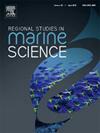Towards an ecosystem approach to a simulated floating wind farm combined with climate change in the Bay of Biscay (France)
IF 2.1
4区 环境科学与生态学
Q3 ECOLOGY
引用次数: 0
Abstract
The Bay of Biscay includes areas of environmental importance, with a wide variety of benthic habitats and rich biodiversity. However, it experiences strong anthropogenic pressures, and the effects of climate change are already evident. Renewable energy infrastructures are set to be installed with the aim of reducing the carbon footprint by 2050. However, their effects on the environment demonstrate the need for holistic studies prior to project design. The Ecopath with Ecosim model can be used to model the entire food web and explore different scenarios for changes in the Bay of Biscay. In this study, four scenarios are developed: (1) a reference scenario based on the 2007–2016 environmental conditions; (2) a climate change scenario (increased production and consumption rates of fish to reflect rising sea temperature, presence of non-indigenous species and local distribution maps derived from species distribution models); (3) an offshore wind farm scenario (a biofouling group, wind farm area closed to fishing activities and increased suitability of the area for species likely to aggregate under the turbines); (4) a cumulative effects scenario. The results are analyzed in terms of biomass and catches within the wind farm and the surrounding area. The main findings are that (1) the arrival of non-indigenous species could lead to a change in the structure of the local food web, resulting in a general increase in fish biomass; (2) the attractiveness of the wind farm generates cascading effects; (3) the combination of the wind farm and climate change could cause contrasting effects on biomass and catches depending on the trophic groups, as well as a potential reorganization of the current food web. These results reflect potential effects of floating wind farms on the structure of the food web that should be considered in fisheries management scenarios in the context of a changing environment.
比斯开湾(法国)模拟浮动风电场结合气候变化的生态系统方法
比斯开湾包括对环境有重要意义的地区,有各种各样的底栖生物栖息地和丰富的生物多样性。然而,它经历了强烈的人为压力,气候变化的影响已经很明显。可再生能源基础设施的安装目标是到2050年减少碳足迹。然而,它们对环境的影响表明,在项目设计之前需要进行全面研究。Ecopath with Ecosim模型可用于对整个食物网进行建模,并探索比斯开湾变化的不同场景。本研究构建了四种情景:①基于2007-2016年环境条件的参考情景;(2)气候变化情景(鱼类产量和消费率增加,以反映海水温度上升、非本地物种的存在和由物种分布模型得出的本地分布图);(3)海上风电场情景(一个生物污垢组,风电场区域关闭捕鱼活动,增加了该区域对可能聚集在涡轮机下的物种的适宜性);(4)累积效应情景。结果是根据风力发电场和周围地区的生物量和捕获量进行分析的。结果表明:(1)非本地物种的到来可能导致本地食物网结构的变化,导致鱼类生物量的普遍增加;(2)风电场的吸引力产生级联效应;(3)风力发电场和气候变化的结合可能会对生物量和捕获量产生不同的影响,这取决于营养组,以及当前食物网的潜在重组。这些结果反映了浮动风力发电场对食物网结构的潜在影响,在不断变化的环境背景下,渔业管理方案应考虑到这一点。
本文章由计算机程序翻译,如有差异,请以英文原文为准。
求助全文
约1分钟内获得全文
求助全文
来源期刊

Regional Studies in Marine Science
Agricultural and Biological Sciences-Ecology, Evolution, Behavior and Systematics
CiteScore
3.90
自引率
4.80%
发文量
336
审稿时长
69 days
期刊介绍:
REGIONAL STUDIES IN MARINE SCIENCE will publish scientifically sound papers on regional aspects of maritime and marine resources in estuaries, coastal zones, continental shelf, the seas and oceans.
 求助内容:
求助内容: 应助结果提醒方式:
应助结果提醒方式:


